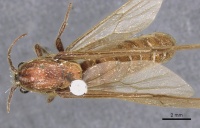Neivamyrmex longiscapus
| Neivamyrmex longiscapus | |
|---|---|

| |
| Scientific classification | |
| Kingdom: | Animalia |
| Phylum: | Arthropoda |
| Class: | Insecta |
| Order: | Hymenoptera |
| Family: | Formicidae |
| Subfamily: | Dorylinae |
| Genus: | Neivamyrmex |
| Species: | N. longiscapus |
| Binomial name | |
| Neivamyrmex longiscapus Borgmeier, 1953 | |
Jack Longino reports that he knows this species from two males collected during a Project ALAS light trapping program in 1998-1999. He also has an earlier record based on material collected by Brian Brown and sent to Julian Watkins for identification. The species is known only from males.
Borgmeier (1955) suggested it was close to Neivamyrmex pilosus. Since the worker of Neivamyrmex impudens was close to the worker of N. pilosus, he suggested N. longiscapus might be the male of N. impudens.
CO1 (DNA barcode) sequence data (courtesy Alex Smith and BOLD) confirm that N. impudens workers and N. longiscapus males from a site in Guatemala are the same. Jack now considers N. longiscapus a junior synonym of N. impudens and has changed his specimen database accordingly.
Identification
Distribution
Latitudinal Distribution Pattern
Latitudinal Range: 18.18333333° to 17.36555556°.
| North Temperate |
North Subtropical |
Tropical | South Subtropical |
South Temperate |
- Source: AntMaps
Distribution based on Regional Taxon Lists
Neotropical Region: Costa Rica (type locality), Guatemala, Mexico, Panama.
Distribution based on AntMaps
Distribution based on AntWeb specimens
Check data from AntWeb
Countries Occupied
| Number of countries occupied by this species based on AntWiki Regional Taxon Lists. In general, fewer countries occupied indicates a narrower range, while more countries indicates a more widespread species. |

|
Estimated Abundance
| Relative abundance based on number of AntMaps records per species (this species within the purple bar). Fewer records (to the left) indicates a less abundant/encountered species while more records (to the right) indicates more abundant/encountered species. |

|
Biology
Castes
Images from AntWeb
  
| |
| Male (alate). Specimen code casent0902308. Photographer Z. Lieberman, uploaded by California Academy of Sciences. | Owned by NHMUK, London, UK. |
Nomenclature
The following information is derived from Barry Bolton's Online Catalogue of the Ants of the World.
- longiscapus. Neivamyrmex longiscapus Borgmeier, 1953: 27, figs. 4, 25, 26 (m.) COSTA RICA, GUATEMALA.
- Type-material: holotype male, 16 paratype males.
- Type-locality: holotype Costa Rica: Santa Clara Prov., Hamburgfarm, 22.v.1936, at light (F. Nevermann); paratypes: 4 males with same data, 7 males with same data but 10.v.1925, and 1.vi.1926 (F. Nevermann), 1 male with same locality but no. 198 (Reichensperger), 2 males Guatemala: Cayuga (W. Schaus), 2 males Guatemala: Trace (= Tres?) Aguas (O.F. Cook).
- Type-depositories: MZSP (holotype); MZSP, USNM (paratypes).
- Status as species: Borgmeier, 1955: 383 (redescription); Kempf, 1972a: 156; Watkins, 1976: 28 (in key); Watkins, 1982: 214 (in key); Bolton, 1995b: 289; Branstetter & Sáenz, 2012: 254.
- Distribution: Costa Rica, Guatemala, Mexico.
Description
References
- Borgmeier, T. 1953. Vorarbeiten zu einer Revision der neotropischen Wanderameisen. Stud. Entomol. 2: 1-51. (page 27, figs. 4, 25, 26 male described)
- Borgmeier, T. 1955. Die Wanderameisen der neotropischen Region. Stud. Entomol. 3: 1-720 (page 383, see also)
References based on Global Ant Biodiversity Informatics
- Borgmeier T. 1955. Die Wanderameisen der neotropischen Region. Studia Entomologica 3: 1-720.
- Dattilo W. et al. 2019. MEXICO ANTS: incidence and abundance along the Nearctic-Neotropical interface. Ecology https://doi.org/10.1002/ecy.2944
- Del Toro, I., M. Vázquez, W.P. Mackay, P. Rojas and R. Zapata-Mata. Hormigas (Hymenoptera: Formicidae) de Tabasco: explorando la diversidad de la mirmecofauna en las selvas tropicales de baja altitud. Dugesiana 16(1):1-14.
- Delabie J. H. C., and I. C. do Nascimento. 1998. As Formigas do municipio de Ilhéus (Insecta: Hymenoptera: Formicidae). Especiaria 1(2): 133-152.
- Esteves F. A., C. R. F. Brandao, and L. P. Prado. 2011. The type specimens of Dorylomorph ants (Hymenoptera, Formicidae: Aenictinae, Ecitoninae, Cerapachyinae, Leptanilloidinae) deposited in the Museu de Zoologia da Universidade de Sao Paulo, Brazil. Papeis Avulsos de Zoologia 51(22): 341-397.
- Fernandes, P.R. XXXX. Los hormigas del suelo en Mexico: Diversidad, distribucion e importancia (Hymenoptera: Formicidae).
- Fernández, F. and S. Sendoya. 2004. Lista de las hormigas neotropicales. Biota Colombiana Volume 5, Number 1.
- Kempf, W.W. 1972. Catalago abreviado das formigas da regiao Neotropical (Hym. Formicidae) Studia Entomologica 15(1-4).
- Vasquez-Bolanos M. 2011. Checklist of the ants (Hymenoptera: Formicidae) from Mexico. Dugesiana 18(1): 95-133.
- Vásquez-Bolaños M. 2011. Lista de especies de hormigas (Hymenoptera: Formicidae) para México. Dugesiana 18: 95-133
- Watkins II, J.F. 1982.The army ants of Mexico (Hymenoptera: Formicidae: Ecitoninae). Journal of the Kansas Entomological Society 55(2): 197-247.
- Watkins J. F., II 1976. The identification and distribution of New World army ants (Dorylinae: Formicidae). Waco, Texas: Baylor University Press, 102 pp

